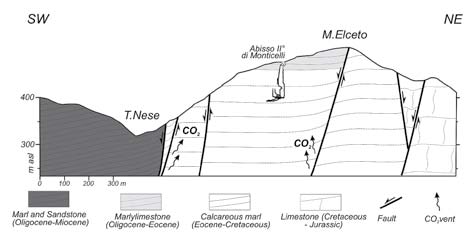Hypogenic caves in Western Umbria (Central Italy)
DOI:
https://doi.org/10.3986/ac.v40i1.33Povzetek
Three karst areas located in the western sector of the Umbria Region (Central Italy) are here described: one northof Perugia, and the others to the south, close to Todi. All the end members of karst processes, from solution caves to Quaternary travertine deposits, are present in this region, associated withCO2 and H2S emissions. The geological and hydrogeological aspects of the main karst systems are analyzed and their underground morphologies and patterns taken into account. Caves have different sizes and vary from a single conduit to complex systems, where the passages show features related to a possible hypogenic speleogenesis. In the area northof Perugia there are small horizontal and vertical solution caves developed in poorly karstified marly limestone, along fracture systems, where phreatic morphologies are prevalent. The endogenic CO2 emissions seem to drive the underground karst evolution. Pozzi della Piana, located west of the town of Todi, is a fossil branchform network cave system developed in a Quaternary travertine and extending for more than 2500 m. The cave passages are arranged on at least two levels, withphreatic morphologies, cupola ceilings, and blind pits. Microcrystalline spalled gypsum blocks are associated withcusp features and wall pockets. The cave-forming process is believed to be linked to travertine deposition by supersaturated carbonate hydrothermal water richin H2S. In the Parrano area, the underground karst system consists of solution caves extending for many hundreds of meters at different elevations in bothsides of a small gorge. The cave patterns vary from single conduits to ramiform passages withanastomotic galleries and pits that intercept the water table witha temperature of 26°C, p CO2 of 10-1 atm, and H2S concentrations of 10 mg/l. Spongework, corrosion pockets, and cupola ceilings are common morphologies, withgypsum replacing limestone wall deposits. Cave formation by hypogenic speleo genesis is also well known in the Apennine karst system of M. Cucco and Frasassi, where bothfossil and active processes are observable. The same processes are responsible for the genesis of these karst systems in different geological and hydrogeological contexts.
Prenosi

Prenosi
Objavljeno
Kako citirati
Številka
Rubrike
Licenca
Avtorji jamčijo, da je delo njihova avtorska stvaritev, da v njem niso kršene avtorske pravice tretjih oseb ali kake druge pravice. V primeru zahtevkov tretjih oseb se avtorji zavezujejo, da bodo varovali interese založnika ter da bodo povrnili morebitno škodo.
Podrobneje v rubriki: Prispevki




